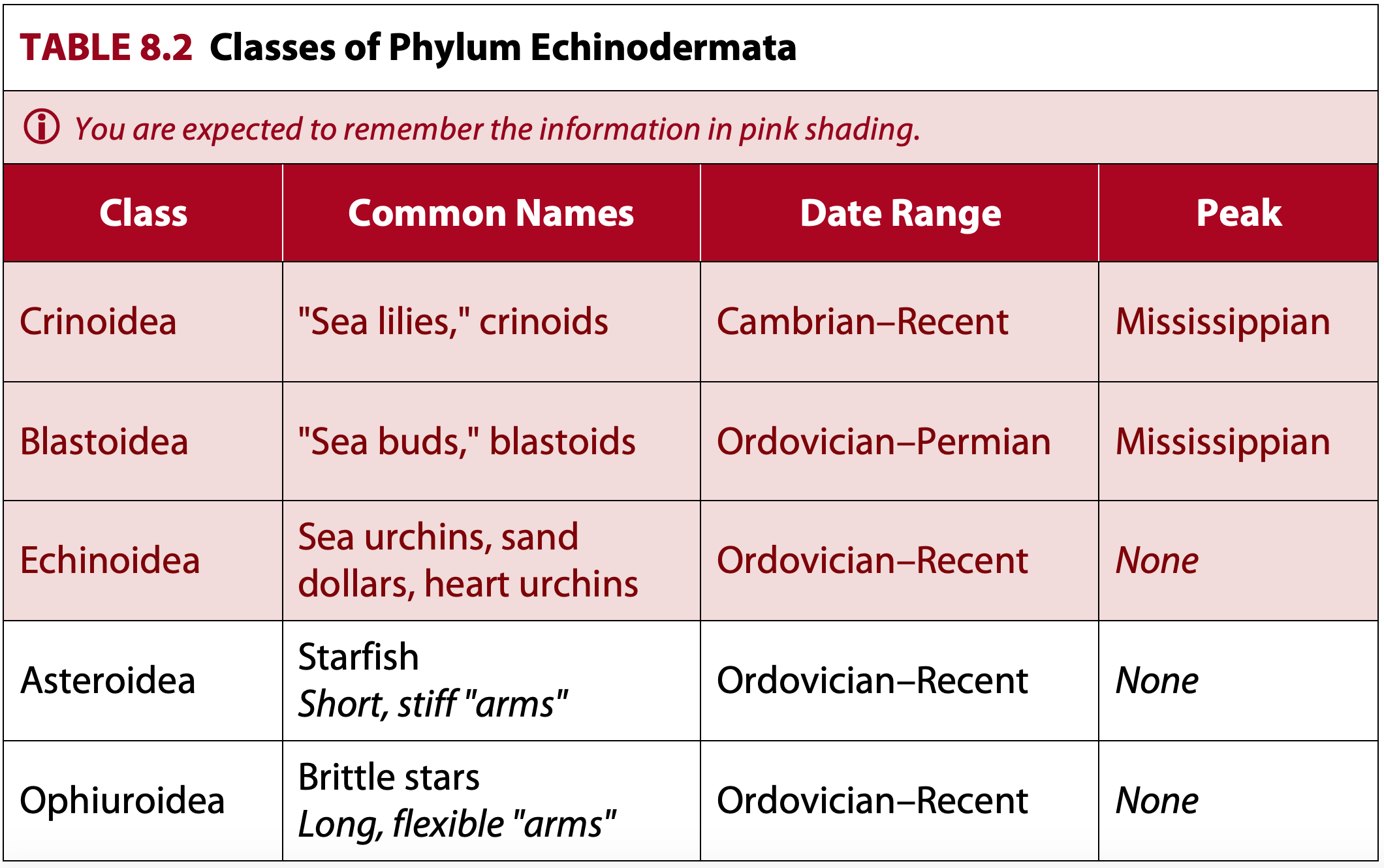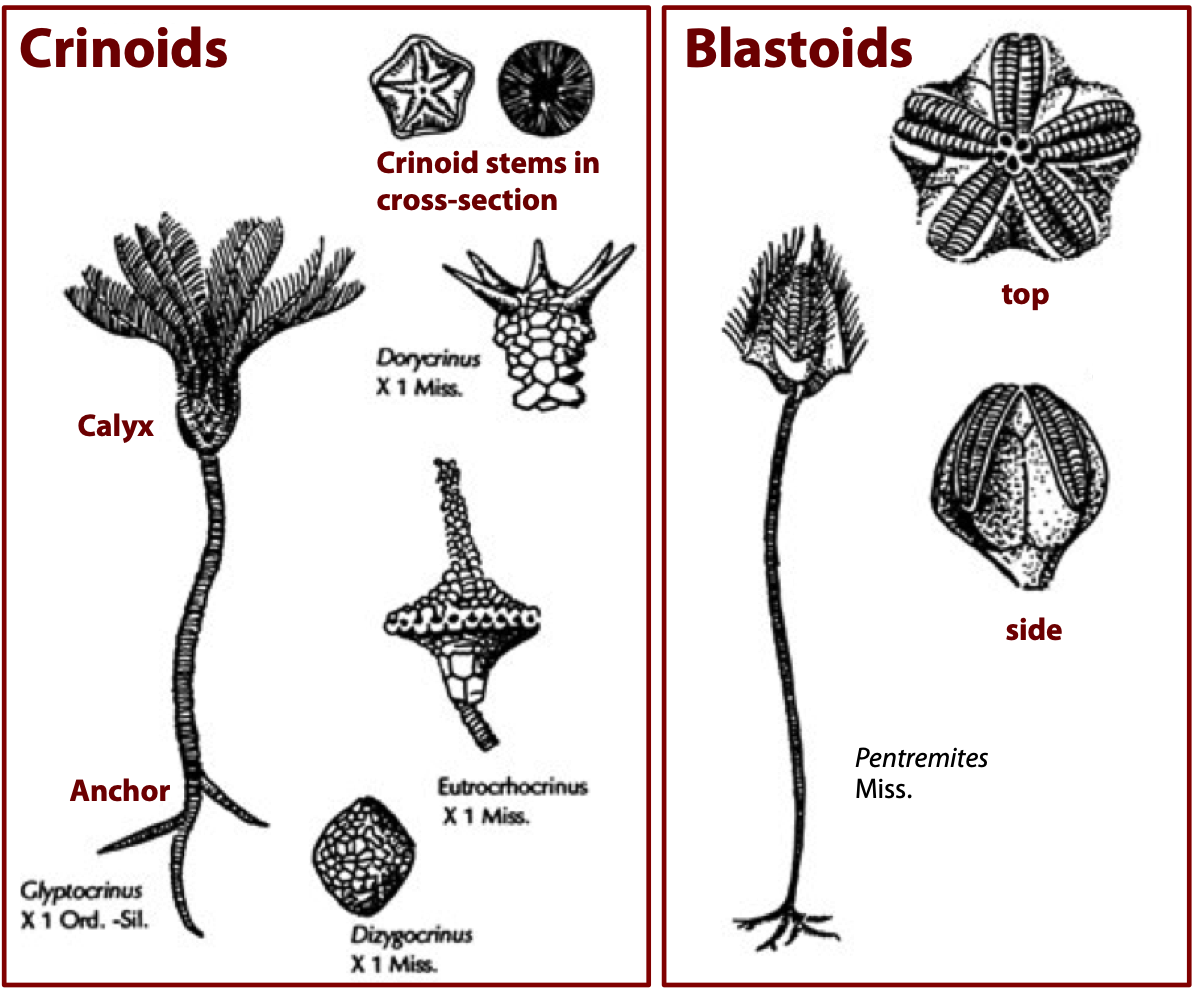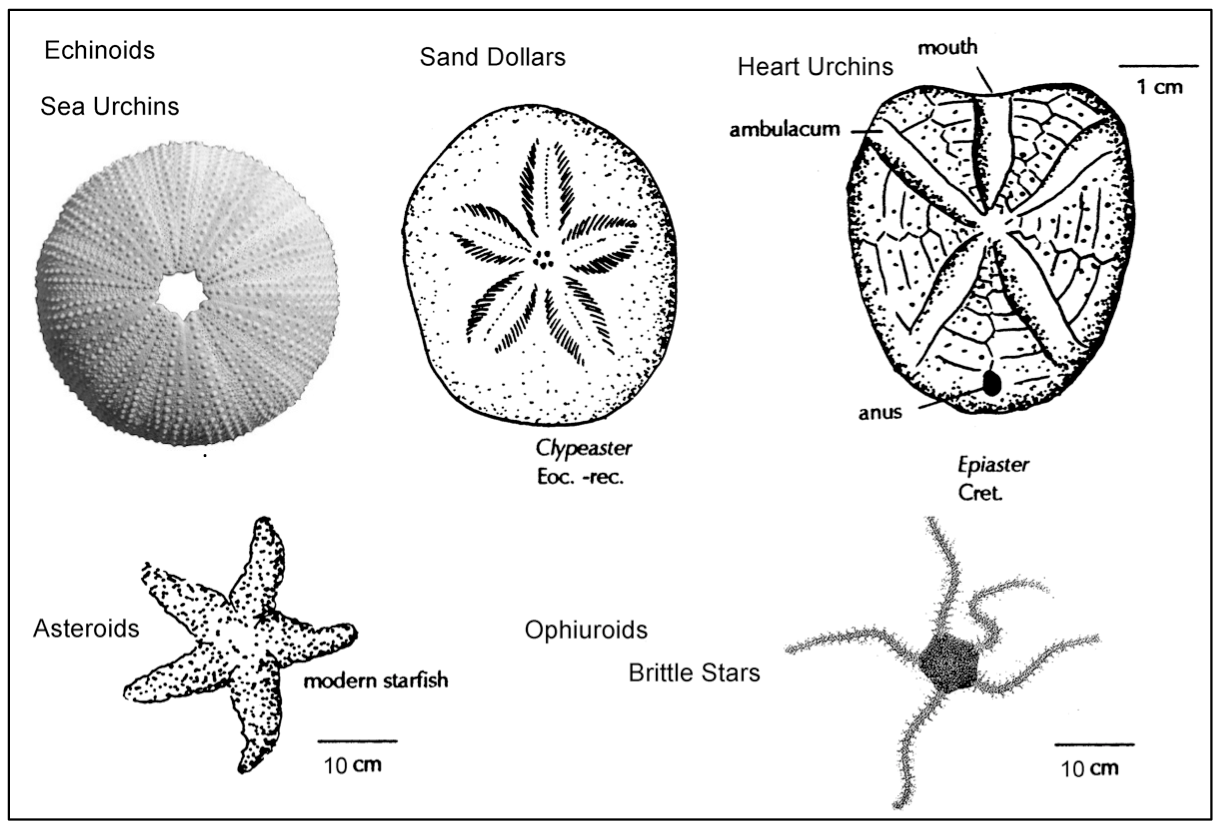Phylum Echinodermata
Echinodermata (the echinoderms) encompasses a wide range of forms, but all are exclusively benthic or bottom-dwelling marine animals. This phylum includes starfish, brittle stars, sea urchins, sand dollars, and sea lilies (Table 8.2).

All have an internal skeleton of small, porous plates made of calcite that are held together with soft tissue. Because the calcite plates are held together by soft tissues, upon death the bodies of many echinoderms tend to disintegrate and the whole organism only rarely survives intact. Exceptions are the sea urchins whose shells often survive intact, though they are fragile. In the case of blastoids, the feeding structure at the top of the animal is most often preserved.
Most echinoderms exhibit pentameral (five-sided) radial symmetry, though some have more dominant bilateral symmetry. Pentameral symmetry looks like five “pie slices” of tissue that are identical in form and layout, although in some echinoderms these “slices” are not necessarily identical in size and shape. For example, sand dollars have five visible “wedges” to their morphology, but are actually bilaterally symmetric from side to side. Starfish, however, are an echinoderm with perfect pentameral symmetry. Other species may have symmetry in multiples of five (5, 10, 15, etc.).
Animals with radial symmetry tend to be suspension feeders or passive predators that wait for food to come to them rather than actively hunting their prey. Most echinoderms follow this rule; even the mobile forms do not actively hunt prey, but instead are opportunistic feeders that consume algae or organics in the sediment.
Echinoderms are grouped as sessile or mobile (see Lab 7 for review of life habits). The sessile group includes Class Crinoidea and Class Blastoidea. Class Echinoidea, Class Asteroidea and Class Ophiuroidea are the mobile echinoderms.
Want to Know More About the Relationship Between Echinoderms and Vertebrates?
Echinoderm embryos develop differently than all other invertebrates. A fertilized egg divides into two, then four, then eight. Eight spheres can be arranged so that the upper four cells rest directly on top of the bottom four (radial cleavage). This arrangement is symmetrical side to side and top to bottom. You can also stack the top four on the bottom four by rotating the top so that they rest in the hollows of the lower four (spiral cleavage). Echinoderms and all the chordates (things with spinal cords, which includes vertebrates) show radial cleavage, which indicates that echinoderms shared an ancestor with chordates.
Sessile Echinoderms: Classes Crinoidea & Blastoidea
The sessile (immobile) classes are the crinoids (sea lilies) and the blastoids. Of these, only crinoids still live today. These forms look more like plants than animals (Figure 8.11). They have a flexible stalk that anchors them to the sea floor, composed of muscular tissue strengthened by button-like plates stacked one on top of the other. At the top of the stem is a calyx, a bud-like structure, made up of calcite plates. Feather-like appendages extended from these buds to obtain food from the water column, making them suspension feeders.

As explained above, the decay of the soft tissues after death means that the whole organisms are rarely preserved. Usually a debris pile of stem plates is what remains in the fossil record, although occasionally the calyx remains intact and is the only way to identify the echinoderm class.
The sessile classes differ in the composition of their calyx and the body parts that tend to be preserved. Both the crinoids and blastoids have cup-like calyxes. A crinoid calyx is composed of many small plates and is rarely preserved, while a blastoid calyx has fewer plates that tend to stay together after death. Crinoid stems are more common in the fossil record, and display radial symmetry in cross-section (Figure 8.11).
A. Sample 10: Crinoid Stems
These samples may be picked up but please treat them with care.
This is the stem portion of the animal that attached to the substrate. These are made up of multiple rings of calcite that were held together with soft tissue. Observe the ends of the stem and note the symmetry exhibited. If you are unable to look at a physical sample, the last slide shows a close-up view of stem fragments from crinoids with a similar morphology.
Question a
B. Sample FGC3: Crinoid Stems
Please do not touch these specimens.
Without touching the specimens themselves, pick up the container and observe the ends of these crinoid stems. If you are unable to look at a physical sample, the last slide shows a close-up view of stem fragments from crinoids with a similar morphology.
Question b
C. Sample GC5: Crinoid Stems in Calcite
This sample may be picked up but please treat it with care.
This is a rock that we have seen before in previous labs.
Questions c-e
c. What type of preservation do we see in the crinoid stems throughout this sample?
d. Going back to what you learned in Lab 1, what is the name of this carbonate rock?
e. Judging from the fractured stems what could you say about the energy of the sedimentary environment that this rock was created in?
The next two crinoid stem samples lived in different environments. Compare their structures.
D. Sample L8: Crinoid Stems
This sample may be picked up but please treat it with care.
E. Sample FFC4: Crinoid Stems
This sample may be picked up but please treat it with care.
Question f
F. Sample 121-45: Articulated Crinoid
This sample may be picked up but please treat it with care.
These sample shows the upper part of a crinoid including stem, calyx and multiple branching arms extending from the calyx.
Question g
G. Sample L8A: Intact Crinoids
PLEASE DO NOT TOUCH. This sample is very fragile.
These structures are the calyx (the “head”) of the crinoids from which multiple branching arms extend. If you look carefully, you can see several intact calyxes throughout the sample. (Note: A brachiopod snuck into the sample too).
Question h
H. Samples 8 & GD1: Blastoid Calyx
These samples may be picked up but please treat them with care.
These are the calyxes of blastoid animals. Use the Fossil Identification Flowchart to correctly identify these samples as blastoids.
Question i
I. Sample 121-39: Blastoids
PLEASE DO NOT TOUCH. This sample is very fragile.
This specimen shows a number of blastoid calyxes that have been preserved together.
Question j
j. Two structures are highlighted in the last slide. What part of the blastoid are they? Explain your reasoning.
Mobile Echinoderms: Classes Echinoidea, Asteroidea, & Ophiuroidea
The mobile classes are the asteroids, the ophiuroids and the echinoids (Figure 8.12).

The asteroids include starfish, which are five-armed (or more) benthic organisms. They range from being suspension feeders to predators. The ophiuroids include the brittle stars, which have five slender arms that radiate from a central disk. They are sediment eaters or suspension feeders, living in deeper water where there are fewer predators.
Echinoids have a body encased in a rounded or flattened shell. They have holes in their shells that occur in distinct rows, from which appendages extend that aid in locomotion, attachment, and feeding. The sea urchins tend to have more rounded shapes. Most species of sea urchins live on the sediment surface and scrape algae from the sea floor. They have spines on the outside of their shells to provide protection from predators.
Other echinoids burrow into the sediment and either suspension feed or eat sediment. In high energy environments such as the tidal zone, these burrowing echinoids tend to be flat (sand dollars) which makes them less likely to be dislodged. They are also efficient burrowers in case they must dig themselves back into the sediment. A third group lives deeper in the sediment (heart urchins), and because they are more protected they have more rounded shapes, which can approach a heart shape. None of the burrowing echinoids have spines.
J. Sample 16: Sand Dollars
These samples may be picked up but please treat them with care.
Questions k-m
k. Sketch fossil Sample 16 from the top, and mark on it the five lines that separate the five “wedges” of the pentameral symmetry.
l. Next, on the drawing above, identify the line about which the animal actually forms a mirror image from side to side (the line of bilateral symmetry).
m. Describe the life habit of this animal (see Lab 7).
K. Sample 121-37: Heart Urchin
This sample may be picked up but please treat it with care.
Question n
L. Sample 121-47: Sea Urchin
These samples may be picked up but please treat them with care.
Notice the small round shapes on the surface of this animal. This is where spines used to attach. Use the fossil identification flow chart to correctly identify this animal. Use the lines in Slide 3 to help you spot the double rows of pores that illustrate the pentameral symmetry.
Question o
